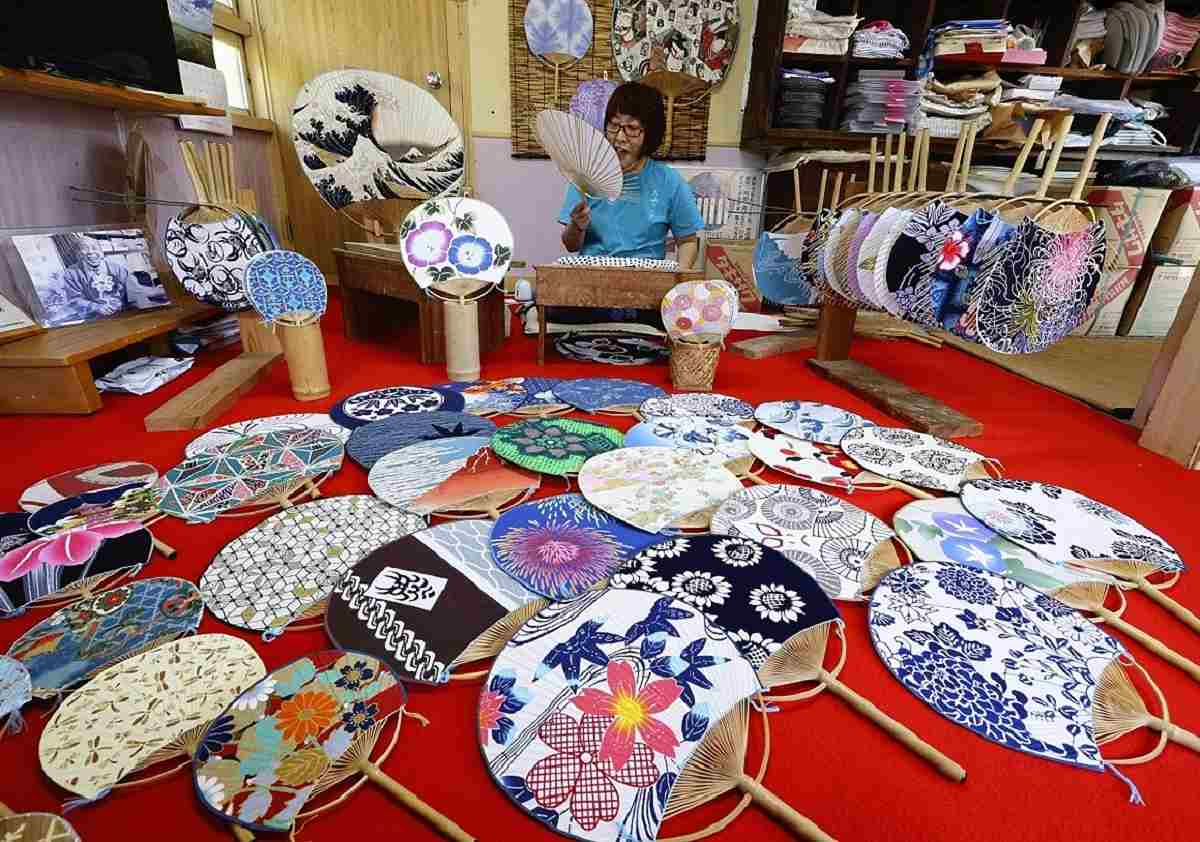Traditional Hanheld Fan Boshu Uchiwa: Production in Full Swing After Great Kanto Earthquake

Colorful Boshu Uchiwa fans are seen at a workshop in Miami-Boso, Chiba Prefecture.
14:00 JST, August 25, 2024
MINAMI-BOSO, Chiba — The Boshu Uchiwa handheld fan is one of Japan’s three most famous uchiwa fans, along with the Marugame Uchiwa in Kagawa and the Kyo Uchiwa in Kyoto. A total of 21 processes are employed in making it, each of which showcases exquisite craftsmanship.
At the Uyama Kobo workshop in Minami-Boso, Chiba Prefecture, Mayumi Uyama, the second-generation representative, puts the finishing touches on her work.
Boshu Uchiwa are crafted from medake bamboo, a wild-growing species in Minami-Boso. The bamboos are cut down in November and December, cut into appropriate lengths, peeled, washed, polished and dried in the sun. The bones of the uchiwa are constructed from bamboo that has been split into 48 to 64 pieces, which are then woven together with thread. The bones are then spread using the bow-shaped bamboo and covered with paper or cloth. The handle of the uchiwa is cylindrical in shape, preserving the distinctive characteristics of the bamboo.
While the colors and patterns of the paper and cloth are often the focus of attention, Uyama said, “The key is the framework. The most crucial aspect is the utilization of well-strung medake bamboo to create a soft breeze.” Compared to ordinary uchiwa, the flexibility is different. The breeze seems to blow softly when the uchiwa is moved slowly, without any flapping of the arms.
The origin of the Boshu Uchiwa can be traced to when specialty bamboo material was shipped to Edo (now Tokyo), which was the center of uchiwa production. Uchiwa production in Boshu began in 1877 in what is now Nago, Tateyama. In the beginning, only the framework was manufactured and finished as “Edo Uchiwa” in Tokyo. However, following the Great Kanto Earthquake of 1923, Tokyo-based uchiwa wholesalers relocated to what is present-day Funakata, Tateyama, where they initiated the start-to-finish production process.
At its peak, from the end of the Taisho era (1912-1926) to the beginning of the Showa era (1926-1989), approximately 7 to 8 million uchiwa were produced annually as a practical item for keeping cool and starting fires. The region of Minami-Boso has a long tradition of a thriving fishing industry, and the women who stayed at home produced uchiwa in a division of labor as a side business.
The advent of electric fans, air conditioners and gas stoves has led to a decline in production to a few tens of thousands per year. The division of labor has been disrupted due to the aging of artisans and the lack of successors. Although it is one of the three major uchiwa manufacturers, it is far behind Marugame Uchiwa in terms of market share.
In order to provide training for artisans, the Boshu Uchiwa promotion council initiated an introductory course for those involved in the industry in fiscal 2014. Additionally, it is holding training sessions for advanced trainees.
Related Tags
"Society" POPULAR ARTICLE
-

M4.9 Earthquake Hits Tokyo, Neighboring Prefectures
-

M7.5 Earthquake Hits Northern Japan; Tsunami Waves Observed in Hokkaido, Aomori and Iwate Prefectures
-

Israeli Tourists Refused Accommodation at Hotel in Japan’s Nagano Pref., Prompting Protest by Israeli Embassy and Probe by Prefecture
-

Tsukiji Market Urges Tourists to Avoid Visiting in Year-End
-

M5.7 Earthquake Hits Japan’s Kumamoto Pref., Measuring Upper 5 Intensity, No Tsunami Expected
JN ACCESS RANKING
-

Keidanren Chairman Yoshinobu Tsutsui Visits Kashiwazaki-Kariwa Nuclear Power Plant; Inspects New Emergency Safety System
-

Imports of Rare Earths from China Facing Delays, May Be Caused by Deterioration of Japan-China Relations
-

University of Tokyo Professor Discusses Japanese Economic Security in Interview Ahead of Forum
-

Japan Pulls out of Vietnam Nuclear Project, Complicating Hanoi’s Power Plans
-

Govt Aims to Expand NISA Program Lineup, Abolish Age Restriction




















